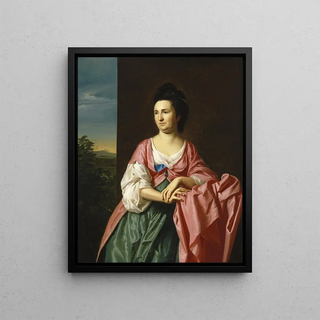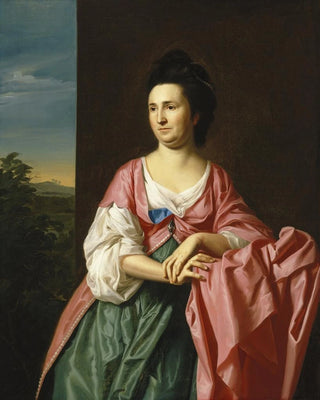Art print | Mrs. Sylvester Gardiner, née Abigail Pickman, formerly Mrs. William Eppes - John Singleton Copley


View from behind

Frame (optional)
Reproduction of Mme Sylvester Gardiner, née Abigail Pickman, formerly Mme William Eppes - John Singleton Copley – Captivating Introduction
In the panorama of 18th-century American art, John Singleton Copley's work stands out for its ability to capture the very essence of its subjects. The art print of Mme Sylvester Gardiner, née Abigail Pickman, formerly Mme William Eppes, is a perfect example of this mastery. This portrait does not merely freeze a moment; it evokes a story, a social status, and a psychological depth that transcend mere visual representation. Through a subtle play of light and shadow, Copley manages to breathe life into his model, inviting the viewer to delve into the intimate world of colonial bourgeoisie.
Style and uniqueness of the art print
The piece is characterized by striking realism, reflecting a time when portraiture was a means of social and political communication. Copley, a virtuoso of oil painting, succeeds in conveying not only the physical beauty of Mme Gardiner but also her character and personality. The meticulous details of her dress, the delicate textures of the fabrics, and the serene expression on her face are all elements that testify to the artist's technical skill. The composition is carefully orchestrated, with a background that, although discreet, contributes to the overall atmosphere of dignity and refinement. This art print is not limited to a simple representation; it is a true window into the world of the aristocracy of the time, a world where every gesture and accessory matter.
The artist and his influence
John Singleton Copley, born in Boston in 1738, is often regarded as one of the greatest portraitists of his era. His career is marked by a fascinating transition between European classical art and emerging American influences. Using techniques inherited from European masters, while developing a unique sensitivity to American culture, Copley managed to build a bridge between two worlds. His work not only influenced his contemporaries but also paved the way for future artists seeking to explore American identity through the lens of painting. Copley captured the spirit of his time, and his legacy continues to inspire.

Matte finish

View from behind

Frame (optional)
Reproduction of Mme Sylvester Gardiner, née Abigail Pickman, formerly Mme William Eppes - John Singleton Copley – Captivating Introduction
In the panorama of 18th-century American art, John Singleton Copley's work stands out for its ability to capture the very essence of its subjects. The art print of Mme Sylvester Gardiner, née Abigail Pickman, formerly Mme William Eppes, is a perfect example of this mastery. This portrait does not merely freeze a moment; it evokes a story, a social status, and a psychological depth that transcend mere visual representation. Through a subtle play of light and shadow, Copley manages to breathe life into his model, inviting the viewer to delve into the intimate world of colonial bourgeoisie.
Style and uniqueness of the art print
The piece is characterized by striking realism, reflecting a time when portraiture was a means of social and political communication. Copley, a virtuoso of oil painting, succeeds in conveying not only the physical beauty of Mme Gardiner but also her character and personality. The meticulous details of her dress, the delicate textures of the fabrics, and the serene expression on her face are all elements that testify to the artist's technical skill. The composition is carefully orchestrated, with a background that, although discreet, contributes to the overall atmosphere of dignity and refinement. This art print is not limited to a simple representation; it is a true window into the world of the aristocracy of the time, a world where every gesture and accessory matter.
The artist and his influence
John Singleton Copley, born in Boston in 1738, is often regarded as one of the greatest portraitists of his era. His career is marked by a fascinating transition between European classical art and emerging American influences. Using techniques inherited from European masters, while developing a unique sensitivity to American culture, Copley managed to build a bridge between two worlds. His work not only influenced his contemporaries but also paved the way for future artists seeking to explore American identity through the lens of painting. Copley captured the spirit of his time, and his legacy continues to inspire.






